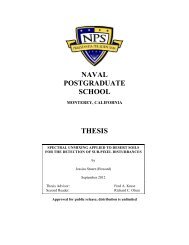October 2000 Newsletter - Naval Postgraduate School
October 2000 Newsletter - Naval Postgraduate School
October 2000 Newsletter - Naval Postgraduate School
Create successful ePaper yourself
Turn your PDF publications into a flip-book with our unique Google optimized e-Paper software.
RESEARCH AND EDUCATION<br />
WEAPONEERING: FROM A JTCG/ME PERSPECTIVE, continued from page 12<br />
from an analyst’s point of view how the basic Single Sortie Probability<br />
of Damage (SSPD) is computed for various weapon/target<br />
combinations. An example of one such scenario is shown in Figure<br />
3, and is a screen from an unclassified version of a weaponeering<br />
program similar to JAWS.<br />
The course is classified as SECRET, not because of the classroom<br />
material, but because it was expected that discussion of first hand<br />
experiences by the students would quickly get to the classified level,<br />
and this has proven to be the case.<br />
In the first class there were 13 students representing a very broad<br />
range of backgrounds for such a small group. There were 5 curricula<br />
represented (Operations Analysis, Combat Systems Sciences and<br />
Technology, <strong>Naval</strong>/Mechanical Engineering, Aeronautical Engineering,<br />
and the NPS/Test Pilot <strong>School</strong> Cooperative Program), representatives<br />
from the Navy, Army and Marine Corps, USN surface and<br />
submarine communities, and aviators from FA-18, FA-14, AV-8B,<br />
A-6 aircraft and H60 helicopters, and a Marine M1A1 tanker.<br />
There is no textbook available, but Professor Driels has prepared<br />
--continued on page 47<br />
ME4300 WEAPONEERING – COURSE SYLLABUS, continued from page 12<br />
4.13 Effectiveness assessment for a specific weapon<br />
4.14 Calculation of lethal area<br />
5. Vulnerability Assessment – Advanced Methods<br />
5.1 Introduction<br />
5.2 Computation of vulnerable area – COVART<br />
5.1 COVART shotline analysis<br />
5.2 COVART shotline P k/h<br />
5.3 Output of COVART program<br />
5.4 General full spray model – GFSM<br />
5.5 Orientation of weapon in GFSM scenario<br />
5.6 GFSM target description<br />
5.7 GFSM weapon description<br />
5.8 GFSM fragment drag data<br />
5.9 Computational model<br />
5.10 GFSM computation of P K/H<br />
5.11 GFSM computation of P K/H (r,g)’s<br />
5.12 Review of computational procedure<br />
5.13 Computation of P K/H matrix<br />
5.14 Simplification of lethal area for weaponeering<br />
5.15 Damage function for targets sensitive to blast<br />
6. Weapon Trajectory<br />
6.1 Introduction<br />
6.2 Weapon delivery tactics<br />
6.3 Initial release velocities<br />
6.4 Zero-drag point mass model<br />
6.5 Linear drag model<br />
Figure 3. Example of Weaponeering Program.<br />
6.6 High fidelity models<br />
6.7 Trajectory for LGB’s and missiles<br />
7. Weapon selection<br />
2.1 Aircraft weapons<br />
2.2 Selecting the weapon for the target<br />
PART 2 – THE WEAPONEERING PROCESS<br />
8. Single weapons directed against point targets<br />
8.1 Introduction to single sortie probability of damage<br />
(SSPD)<br />
8.2 SSPD’s using the Carlton damage function<br />
8.3 SSPD’s for unitary blast damage function and point<br />
target<br />
8.4 Some computational considerations<br />
8.5 Force estimation<br />
8.6 Simple spreadsheet implementation to compute<br />
SSPD’s<br />
8.7 Spreadsheet template for implementing<br />
weaponeering solutions<br />
8.8 Calculating SSPD’s for guided weapons<br />
9. Single weapons against area targets<br />
9.1 Effect of area target on SSPD calculation<br />
9.2 Target larger than the damage function<br />
--continued on page 47<br />
NPS Research page 13<br />
<strong>October</strong> <strong>2000</strong>
















